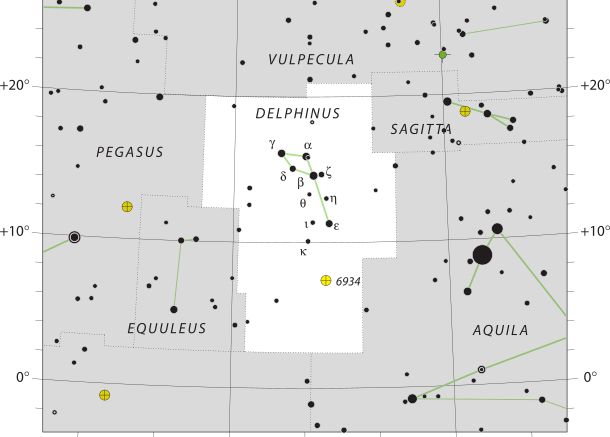Located in the Northern Hemisphere, Delphinus is a small constellation that is close to the celestial equator. The name is the Latin word for the Greek word for dolphin.
Delphinus is one of the 48 constellations listed by the 2nd century astronomer Ptolemy, with the five brightest stars form a distinctive asterism symbolizing a dolphin with four stars representing the body and one the tail.
Delphinus is a faint constellation with only two stars brighter than an apparent magnitude of 4, as Beta Delphini has a magnitude of 3.6 and Alpha Delphini has a magnitude of 3.8.
Delphinus covers 188.5 square degrees in the sky, which corresponds to 0.457% of the sky. This makes the constellation rank 69th of the 88 constellations in size. The whole constellation is visible to observers north of latitude 69°S.
| Applicable Information | |
| Visibility In Pacific Northwest | March to January |
| Best Times To View | September |
| Right Ascension | 20h 14m 14.1594s to 21h 08m 59.6073s |
| Declination | +2.4021468° to +20.9399471° |
| Area | 189 square degrees |
| Main Stars | 5 |
| Brightest Object | Rotanev — β Del |
| Meteor showers | 0 |
| Messier objects | 0 |
| Neighboring Constellations | Vulpecula, Sagitta, Aquila, Aquarius, Equuleus, Pegasus |
The Name
Delphinus is associated with two stories from Greek mythology.
The first story has Delpinus persuade Amphirite to accept Poseidon’s marriage proposal. Out of gratitude for the assistance, the image of a dolphin was placed among the stars.
The second story tells of the Greek poet Arion of Lesbos, who was saved by a dolphin in the 7th century BC.
Chinese astronomy says that the stars of Delphinus are located within the Black Tortoise of the North.
In Polynesia, several cultures have Delphinus as a constellation as the Pukapuka called the constellation Te Toloa and in the Tuamotus called the constellation Te Uru-o-tiki.
Stars
Delphinus has two stars above fourth magnitude, with its brightest star having a magnitude of 3.6.
Gamma Delphini is a binary star that can be viewed by amateur astronomers with small telescope. The stars are orange-gold and light yellow star respectively.
Because of its location in the Milky Way star field, there are many deep-sky objects including NGC 6891, NGC 6905, NGC 6934, and NGC 7006. NGC 6891 is a planetary nebula with a magnitude 10.5, NGC 6905 or the Blue Flash nebula is another planetary nebula in the constellation. NGC 6934 is a globular cluster with a magnitude of 9.75, and the globular cluster NGC 7006 is also fairly dim with a magnitude of 11.5.
Make sure to check out other articles on the site, including a brief introduction to constellations, other constellation articles, and more!

Thanks for sharing. I read many of your blog posts, cool, your blog is very good.